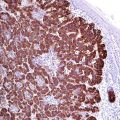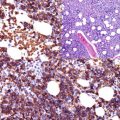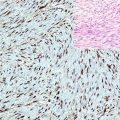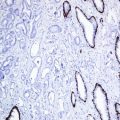, Hans Guski2 and Glen Kristiansen3
(1)
Carl-Thiem-Klinikum, Institut für Pathologie, Cottbus, Germany
(2)
Vivantes Klinikum Neukölln, Institut für Pathologie, Berlin, Germany
(3)
Universität Bonn, UKB, Institut für Pathologie, Bonn, Germany
Diagnostic Antibody Panel
Vimentin, pan-cytokeratin, actin, desmin, HMB45, S100, CD34, CD99, TLE-1.
Transducer-Like Enhancer of Split 1 (TLE-1):
TLE-1 is one of the four transcriptional repressors expressed during the embryogenesis involved in the regulation of hematopoiesis and epithelial and neuronal differentiation [1–4]. TLE-1 is normally expressed in acinar cells of salivary glands. In routine immunohistochemistry, the expression of TLE-1 is mostly characteristic for synovial sarcoma; however, the overexpression of TLE-1 is also reported in different soft tissue tumors including endometrial stromal sarcoma, acral myxoinflammatory fibroblastic sarcoma, solitary fibrous tumor, epithelioid sarcoma, lipoma and liposarcoma, leiomyosarcoma, neurofibroma, malignant nerve sheet tumor, chordoma, mesothelioma, and undifferentiated pleomorphic sarcoma.
Transcription Factor-E3 (TFE-3):
TFE-3 a transcription factor encoded by a gene located on Xp11.2. This gene is the fusion partner of the ASPL gene in the t(X;17) translocation associated with alveolar soft part sarcoma. The generated fusion transcript ASPL-TFE3 causes the activation of the TFE3 gene and the overexpression of the TFE-3 protein. The expression of TFE-3 is characteristic for alveolar soft part sarcoma as well as for the Xp11.2 translocation-associated renal cell carcinoma mentioned in the previous chapter [5].
Brachyury:
Brachyury is a nuclear transcription factor involved in epithelial-mesenchymal transition, normally expressed in notochord and plays a role in the development of posterior and caudal body parts. In adult tissue, brachyury is expressed in the cells of spermatogenesis. In neoplastic tissue, it is a sensitive and specific marker for chordoma expressed in more than 95% of the cases. Brachyury is negative in other tumors with chordoid or myxoid differentiation that mimics chordoma such as chondrosarcoma, chordoid meningioma, and clear cell and epithelioid sarcoma. Brachyury expression is also found in a subset of pulmonary adenocarcinoma, squamous cell carcinoma, and small cell carcinoma and in different germ cell tumors including embryonal carcinoma, seminoma, and yolk sac tumor [6, 7].
Immunophenotype of miscellaneous tumors and tumors of uncertain differentiation | ||||
|---|---|---|---|---|
Tumor type | + in >90% (+) | + in 50–90% (±) | + in 10–50% (∓) | + in <10% (−) |
Synovial sarcoma a | Epithelioid cell components: pan-CK, TLE-1b, bcl-2 Sarcomatous spindle cell components: TLE-1, vimentin, SYT, bcl-2, calponin | SYT, CK7, CK19, EMA, HER-2 calretinin, CD99, CD56, CD57 | CEA, vimentin, calponin E-cadherin, CD34, S100, CD117, pan-CK, EMA, actin | CD34 desmin, caldesmon |
Clear cell sarcoma
Stay updated, free articles. Join our Telegram channel
Full access? Get Clinical Tree
 Get Clinical Tree app for offline access
Get Clinical Tree app for offline access

| ||||





